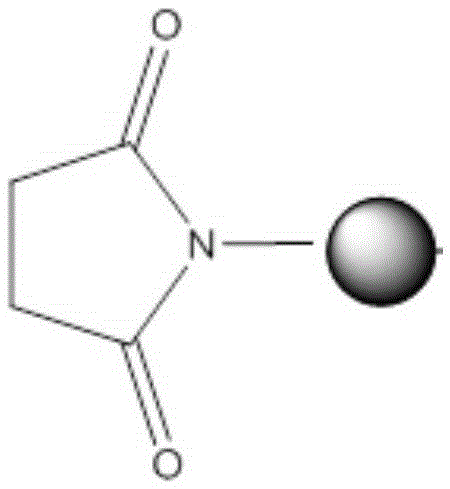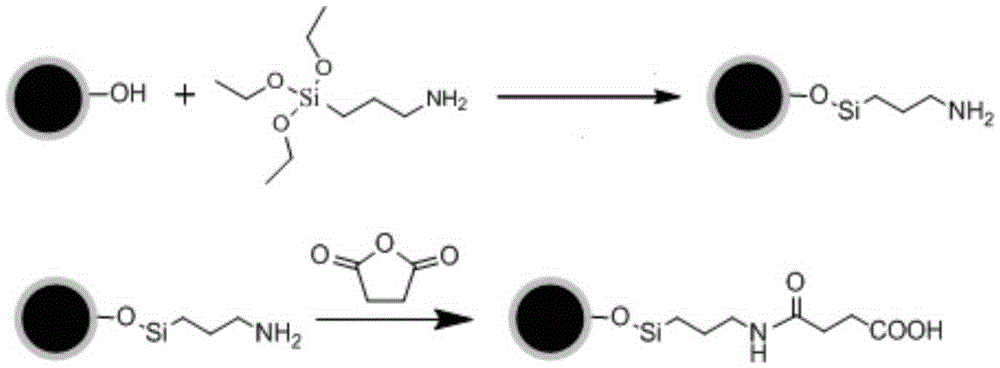Magnetic microspheres for coupling primary amino-containing bioligands and preparation method thereof
A technology of magnetic microspheres and biological ligands, which is applied to the magnetism of organic materials/organic magnetic materials, silicon dioxide, silicon oxide, etc., can solve the problems of damaging the activity of biological ligands, inconvenient use, cumbersome operation, etc., and achieve Increased binding capacity, easy operation, and simplified coupling process
- Summary
- Abstract
- Description
- Claims
- Application Information
AI Technical Summary
Problems solved by technology
Method used
Image
Examples
Embodiment 1
[0038] Preparation of Carboxylated Magnetic Microspheres Using Silica Magnetic Microspheres as Substrate
[0039] Take 1g of silica magnetic microspheres, disperse them in 300mL of isopropanol solvent, then add 0.2mL of silane coupling agent γ-aminopropyl-triethoxysilane, under the condition of 80℃ water bath, mechanically stir the reaction for 3h, end reaction. The product is separated by magnetic suction, the liquid is removed, and finally washed several times with ethanol to obtain magnetic microspheres whose surface is modified with amino groups. Take 1 g of amino-modified magnetic microspheres and disperse them in 0.1 M NaCl aqueous solution, add 6.4 g of succinic anhydride solid, react on a shaking table at room temperature for 5 h, and end the reaction. The product is separated by magnetic suction to remove the liquid, and finally washed several times with 1M NaCl aqueous solution and deionized water to obtain carboxyl magnetic microspheres with magnetic microsphere bo...
Embodiment 2
[0042] Preparation of Carboxylated Magnetic Microspheres Using Magnetic Agarose Microspheres as Substrate
[0043] Suction filter the magnetic agarose microspheres in a sand core filter funnel, weigh 1 g of the magnetic agarose microspheres after suction filtration and disperse them in acetone solvent, add 3 mL of carbonyldiimidazole (CDI) acetone solution, and mix vertically at room temperature for 3 h, End the reaction. The obtained product was separated by magnetic suction to remove liquid, and washed several times with acetone to obtain CDI-activated magnetic agarose microspheres. Take 1 g of CDI-activated magnetic agarose microspheres and disperse them in 10 mL of deionized water, then weigh the solid glycine and add it to make the final concentration 1 mol / L, finally adjust the pH value to 9.0-10.0, react at room temperature for 16 hours, and end reaction. The obtained solid was separated and removed by magnetic suction, and washed with deionized water, 2M NaCl, and de...
Embodiment 3
[0046] Preparation of Carboxylated Magnetic Microspheres Using Magnetic Microspheres Containing Epoxy Groups on the Surface
[0047] Take 1 g of epoxy-based magnetic microspheres in a three-necked flask, add 100 mL of 0.6 M aminocaproic acid solution with a pH of 9.6, and mechanically stir at room temperature for 8 h to end the reaction. The obtained product was separated and removed by magnetic suction, and washed alternately with deionized water, 1M NaCl, and deionized water several times to obtain carboxyl magnetic microspheres with a magnetic microsphere body-arm chain-carboxyl structure.
[0048] Different arm chains can be prepared by changing the added carboxyl modification reagent, such as changing aminocaproic acid to 2-aminoacetic acid, 3-aminopropionic acid, 4-aminobutyric acid, 5-aminopentanoic acid, 7-aminoheptanoic acid, etc. Long carboxyl magnetic microspheres.
PUM
| Property | Measurement | Unit |
|---|---|---|
| concentration | aaaaa | aaaaa |
Abstract
Description
Claims
Application Information
 Login to View More
Login to View More - R&D
- Intellectual Property
- Life Sciences
- Materials
- Tech Scout
- Unparalleled Data Quality
- Higher Quality Content
- 60% Fewer Hallucinations
Browse by: Latest US Patents, China's latest patents, Technical Efficacy Thesaurus, Application Domain, Technology Topic, Popular Technical Reports.
© 2025 PatSnap. All rights reserved.Legal|Privacy policy|Modern Slavery Act Transparency Statement|Sitemap|About US| Contact US: help@patsnap.com



